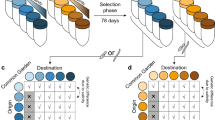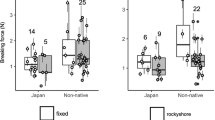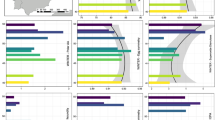Abstract
Within-individual strategies of variation (e.g., phenotypic plasticity) are particularly relevant to modular organisms, in which ramets of the same genetic individual may encounter diverse environments imposing diverse patterns of selection. Hence, measuring selection in heterogeneous environments is essential to understanding whether environment-dependent phenotypic change enhances the fitness of modular individuals. In sublittoral marine habitats, competition for light and space among modular taxa generates extreme patchiness in resource availability. Little is known, however, of the potential for plasticity within individuals to arise from spatially-variable selection in such systems. We tested whether plasticity enhances genet-level fitness in Asparagopsis armata, a clonal seaweed in which correlated traits mediate morphological responses to variation in light. Using the capacity for rapid, clonal growth to measure fitness, we identified aspects of ramet morphology targeted by selection in two contrasting light environments and compared patterns of selection across environments. We found that directional selection on single traits, coupled with linear and nonlinear selection on multi-trait interactions, shape ramet morphology within environments and favor different phenotypes in each. Evidence of environment-dependent, multivariate selection on correlated traits is novel for any marine modular organism and demonstrates that seaweeds, such as A. armata, may potentially adapt to environmental heterogeneity via plasticity in clonal morphology.


Similar content being viewed by others
References
Arenas F, Viejo RM, Fernandez C (2002) Density-dependent regulation in an invasive seaweed: responses at plant and modular levels. J Ecol 90:820–829
Arnold SJ, Pfrender ME, Jones AG (2001) The adaptive landscape as a conceptual bridge between micro- and macroevolution. Genetica 112–113:9–32
Ballaré CL, Scopel AL, Sanchez RA (1997) Foraging for light: photosensory ecology and agricultural implications. Plant Cell Environ 20:820–825
Bisgaard S, Ankenman B (1996) Standard errors for the eigenvalues in second-order response surface models. Technometrics 38:238–246
Björklund M (2003) Variation and selection––what are we measuring? Acta Zoologica Fennica 40:387–394
Blows MW, Brooks R (2003) Measuring non-linear selection. Am Nat 162:815–820
Blows MW, Brooks R, Kraft PG (2003) Exploring complex fitness surfaces: multiple ornamentation and polymorphism in male guppies. Evolution 57:1622–1630
Blows MW, Hoffmann AA (2005) A reassessment of genetic limits to evolutionary change. Ecology 86:1371–1384
Bonin DR, Hawkes MW (1987) Systematics and life histories of New Zealand Bonnemaisoniaceae (Bonnemaisoniales, Rhodophyta): 1. The genus Asparagopsis. NZ J Bot 25:577–590
Bradshaw AD (1965) Evolutionary significance of phenotypic plasticity in plants. Adv Genet 13:115–155
Brodie ED III, Moore AJ, Janzen FJ (1995) Visualizing and quantifying natural selection. Trends Ecol Evol 10:313–318
Brooks R, Hunt J, Blows MW, Smith MJ, Bussière LF, Jennions MD (2005) Experimental evidence for multivariate stabilizing sexual selection. Evolution 59:871–880
Chenoweth SF, Blows MW (2005) Contrasting mutual sexual selection on homologous signal traits in Drosophila serrata. Am Nat 165:281–289
Collado-Vides L (2002a) Clonal architecture in marine macroalgae: ecological and evolutionary perspectives. Evol Ecol 15:531–545
Collado-Vides L (2002b) Morphological plasticity of Caulerpa prolifera in relation to growth form in a coral reef lagoon. Bot Mar 45:123–129
Collado-Vides L, Robledo D (1999) Morphology and photosynthesis of Caulerpa (Chlorophyta) in relation to growth form. J Phycol 35:325–330
Dayton PK (1975) Experimental evaluation of ecological dominance in a rocky intertidal algal community. Ecol Monogr 45:137–159
de Kroon H, Huber H, Stuefer JF, van Groenendael JM (2005) A modular concept of phenotypic plasticity in plants. New Phytol 166:73–82
de Kroon H, Hutchings MJ (1995) Morphological plasticity in clonal plants ––the foraging concept reconsidered. Journal of Ecology 83:143–152
Dixon PS (1964) Asparagopsis in Europe. Nature 204:902
Dong M (1993) Morphological plasticity of the clonal herb Lamiastrum galeobdolon (L.) Ehrend. & Polatschek in response to partial shading. New Phytol 124:291–300
Donohue K, Messiqua D, Pyle EH, Heschel MS, Schmitt J (2000) Evidence of adaptive divergence in plasticity: Density- and site-dependent selection on shade-avoidance responses in Impatiens capensis. Evolution 54:1956–1968
Draper NR, John JA (1988) Response surface designs for quantitative and qualitative variables. Technometrics 30:423–428
Dudley SA, Schmitt J (1996) Testing the adaptive plasticity hypothesis: density-dependent selection on manipulated stem length in Impatiens capensis. Am Nat 147:445–465
Gardner SN, Mangel M (1997) Can a clonal organism escape senescence? Am Nat 150:462–490
Gaylord B, Blanchette CA, Denny MW (1994) Mechanical consequences of size in wave-swept algae. Ecol Monogr 64:287–313
Green PJ, Silverman B W (1994) Nonparametric regression and generalized linear models: a roughness penalty approach. Chapman & Hall, New York
Griffith TM, Sultan SE (2005) Shade tolerance plasticity in response to neutral vs green shade cues in Polygonum species of contrasting ecological breadth. New Phytol 166:141–148
Guiry MD, Dawes CJ (1992) Daylength, temperature and nutrient control of tetrasporogenesis in Asparagopsis armata (Rhodophyta). J Exp Mar Biol Ecol 158:197–217
Harper JL (1985) Modules, branches and the capture of resources. In: Jackson JBC, Buss LW, Cook RE (eds) Population biology and evolution of clonal organisms. Yale University Press, New Haven, pp 1–34
Henry HAL, Aarssen LW (1997) On the relationship between shade tolerance and shade avoidance strategies in woodland plants. Oikos 80:575–582
Hood GM (2004) Poptools 2.6. Available at http://www.cse.csiro.au/poptools
Huber H, Hutchings MJ (1997) Differential response to shading in orthotropic and plagiotropic shoots of the clonal herb Glechoma hirsuta. Oecologia 112:485–491
Huber H, Kane NC, Heschel MS, von Wettberg EJ, Banta J, Leuck A, Schmitt J (2004) Frequency and microenvironmental pattern of selection on plastic shade-avoidance traits in a natural population of Impatiens capensis. Am Nat 163:548–563
Huber H, Lukacs S, Watson M A (1999) Spatial structure of stoloniferous herbs: an interplay between structural blue-print, ontogeny and phenotypic plasticity. Plant Ecol 141:107–115
Huber H, Stuefer JF (1997) Shade-induced changes in the branching pattern of a stoloniferous herb: functional response or allometric effect? Oecologia 110:478–486
Huey RB, Carlson M, Crozier L, Frazier M, Hamilton H, Harley C, Hoang A, Kingsolver JG (2002) Plants versus animals: do they deal with stress in different ways? Integr Comp Biol 42:415–423
Hughes T P, Connell JH (1987) Population dynamics based on size or age? A reef-coral analysis. Am Nat 129:818–829
Jackson JBC, Coates AG (1986) Life cycles and the evolution of clonal (modular) animals. Philos Trans Roy Soc B 313:7–22
Jormalainen V, Honkanen T (2004) Variation in natural selection for growth and phlorotannins in the brown alga Fucus vesiculosus. J Evol Biol 17:807–820
Kaandorp JA, Kübler J (2001) The algorithmic beauty of seaweeds, sponges and corals. Springer-Verlag, Amsterdam
Kingsolver JG, Hoekstra HE, Hoekstra JM, Berrigan D, Vignieri SN, Hill CE, Hoang A, Gibert P, Beerli P (2001) The strength of phenotypic selection in natural populations. Am Nat 157:245–261
Kirk JTO (1994) Light and photosynthesis in aquatic ecosystems. Cambridge University Press, Cambridge
Lande R (1979) Quantitative genetic analysis of multivariate evolution, applied to brain:body size allometry. Evolution 33:402–416
Lande R, Arnold SJ (1983) The measurement of selection on correlated characters. Evolution 37:1210–1226
Lasker HR (1990) Clonal propagation and population dynamics of a gorgonian coral. Ecology 71:1578–1589
Lasker HR, Coffroth MA (1999) Responses of clonal reef taxa to environmental change. Am Zool 39:92–103
Lewontin RC (1978) Adaptation. Sci Am 239:157–169
Lovett Doust L (1981) Population dynamics and local specialization in a clonal perennial (Ranunculus repens). J Ecol 69:743–755
Lüning K (1981) Light. In: Lobban CS, Wynne MJ (eds) The biology of seaweeds. Blackwell, Oxford, pp 326–366
Manly BFJ (2001) Randomization, bootstrap and Monte Carlo methods in biology. Chapman & Hall/C.R.C. Press, Boca Raton
Middelboe AL, Binzer T (2004) Importance of canopy structure on photosynthesis in single- and multi-species assemblages of marine macroalgae. Oikos 107:422–432
Mitchell-Olds T, Shaw RG (1987) Regression analysis of natural selection: statistical inference and biological interpretation. Evolution 41:1149–1161
Monro K, Poore AGB (2005) Light quantity and quality induce shade-avoiding plasticity in a marine macroalga. J Evol Biol 18:426–35
Nishihara GN, Terada R, Noro T (2004) Photosynthesis and growth rates of Laurencia brongniartii J. Agardh (Rhodophyta, Ceramiales) in preparation for cultivation. J Appl Phycol 16:303–308
Nychka D (2004) Fields: tools for spatial data. R package version 1.5. http://www.cgd.ucar.edu/stats/Software/Fields
Pan JJ, Price JS (2002) Fitness and evolution in clonal plants: the impact of clonal growth. Evol Ecol 15:583–600
Phillips PC, Arnold SJ (1989) Visualizing multivariate selection. Evolution 43:1209–1222
Pilson D 2000. The evolution of plant response to herbivory: Simultaneously considering resistance and tolerance in Brassica rapa. Evol Ecol 14:457–489
Preston KA, Ackerly DD (2004) The evolution of allometry in modular organisms. In: Pigliucci M, Preston KA (eds) Modularity and Phenotypic Complexity. Oxford University Press, Oxford, pp 80–106
Pringle A, Chen D, Taylor JW (2003) Sexual fecundity is correlated to size in the lichenized fungus Xanthoparmelia cumberlandia. Bryologist 106:221–225
Puijalon S, Bornette G, Sagnes P (2005) Adaptations to increasing hydraulic stress: morphology, hydrodynamics and fitness of two higher aquatic plant species. J Exp Bot 56:777–786
Quinn GP, Keough MJ (2002) Experimental design and data analysis for biologists. Cambridge University Press, Cambridge
R Development Core Team (2004) R: A language and environment for statistical computing. R Foundation for Statistical Computing, Vienna, Austria. http://www.R-project.org
Rasband WS (2005) ImageJ 1.34. U. S. National Institutes of Health, Bethesda, Maryland, USA. http://www.rsb.info.nih.gov/ij/
Rausher MD (1992) The measurement of selection on quantitative traits: biases due to environmental covariances between traits and fitness. Evolution 46:616–626
Reed DC, Foster MS (1984) The effects of canopy shadings on algal recruitment and growth in a giant kelp forest. Ecology 65:937–948
Rueffler C, Van Dooren TJM, Leimar O, Abrams PA (2006) Disruptive selection and then what? Trends Ecol Evol 21:238–245
Salles S, Aguilera J, Lopez-Figueroa F (1996) Light field in algal canopies: changes in spectral light ratios and growth of Porphyra leucosticta Thur. In Le Jol. Sci Mar 60:29–38
Schluter D, Nychka D (1994) Exploring fitness surfaces. Am Nat 143:597–616
Schmalhausen II (1949) Factors of evolution: the theory of stabilizing selection. Blakiston, Philadelphia
Schmitt J, Stinchcombe JR, Heschel MS, Huber H (2003) The adaptive evolution of plasticity: phytochrome-mediated shade avoidance responses. Integr Comp Biol 43:459–469
Schlichting CD, Pigliucci M (1998) Phenotypic evolution: a reaction norm perspective. Sinauer Associates, Sunderland
Scrosati R, DeWreede RE (1997) Dynamics of the biomass-density relationship and frond biomass inequality for Mazzaella cornucopiae (Gigartinaceae, Rhodophyta): Implications for the understanding of frond interactions. Phycologia 36:506–516
Silander JA (1985) Microevolution in clonal plants. In: Jackson JBC, Buss LW, Cook RE (eds) Population biology and evolution of clonal organisms. Yale University Press, New Haven, pp 107–153
Simms EL (1990) Examining selection on the multivariate phenotype: plant resistance to herbivores. Evolution 44:1177–1188
Starr RC, Zeikus J (1993) UTEX––The culture collection of algae at the University of Texas at Austin. J Phycol 29:1–106
Stanton ML, Thiede DA (2005) Statistical convenience vs biological insight: consequences of data transformation for the analysis of fitness variation in heterogeneous environments. New Phytol 166:319–338
Stearns S, de Jong G, Newman B (1991) The effects of phenotypic plasticity on genetic correlations. Trends Ecol Evol 6:122–126
Steinger T, Roy BA, Stanton ML (2003) Evolution in stressful environments II: adaptive value and costs of plasticity in response to low light in Sinapis arvensis. J Evol Biol 16:313–323
Stewart HL (2006) Ontogenetic changes in buoyancy, breaking strength, extensibility, and reproductive investment in a drifting macroalga Turbinaria ornata (Phaeophyta) J Phycol 42:43–50
Thomsen MS, Wernberg T (2005) What affects the forces required to break or dislodge macroalgae? Eur J Phycol 40:139–148
Tuomi J, Vuorisalo T (1989) Hierarchical selection in modular organisms. Trends Ecol Evol 4:209–213
Van der Velde JT, King RJ (1984) The subtidal seaweed communities of Bare Island, Botany Bay. Wetlands 4:7–22
van Kleunen M, Fischer M (2001) Adaptive evolution of plastic foraging responses in a clonal plant. Ecology 82:3309–3319
van Kleunen M, Fischer M (2005) Constraints on the evolution of adaptive phenotypic plasticity in plants. New Phytol 166:49–60
van Tienderen PH (1991) Evolution of generalists and specialists in spatially heterogeneous environments. Evolution 45:1317–1331
Via S (1993) Adaptive phenotypic plasticity: target or by-product of selection in a variable environment? Am Nat 142:352–365
Via S, Gomulkiewicz R, de Jong G, Scheiner SM, Schlichting CD, van Tienderen PH (1995) Adaptive phenotypic plasticity: consensus and controversy. Trends Ecol Evol 10:212–217
Via S, Hawthorne DJ (2005) Back to the future: genetic correlations, adaptation and speciation. Genetica 123:147–156
Via S, Lande R (1985) Genotype-environment interaction and the evolution of phenotypic plasticity. Evolution 39:505–522
Viejo RM, Åberg P (2001) Effects of density on the vital rates of a modular seaweed. Mar Ecol Prog Ser 221:105–115
Weinig C (2000) Differing selection in alternate competitive environments: shade-avoidance responses and germination timing. Evolution 54:124–136
Weinig C, Delph LF (2001) Phenotypic plasticity early in life constrains developmental responses later. Evolution 55:930–936
Weinig C, Johnston J, German ZM, Demink LM (2006) Local and global costs of adaptive plasticity to density in Arabidopsis thaliana. Am Nat 167:826–836
Witman JD, Dayton PK (2001) Rocky subtidal communities. In: Bertness MD, Gaines SD, Hay ME (eds) Marine community ecology. Sinauer Press, Sunderland, pp 33–366
Womersley HBS (1996) The marine benthic flora of Southern Australia. South Australia Government Printing Division, Adelaide
Acknowledgements
This research was supported by an Australian Postgraduate Award to K. Monro and the Australian Research Council Discovery Project DP0208481 to A. Poore. We thank M. Head, K. Donohue and two anonymous reviewers for insightful comments on an earlier draft of this manuscript.
Author information
Authors and Affiliations
Corresponding author
Rights and permissions
About this article
Cite this article
Monro, K., Poore, A.G.B. & Brooks, R. Multivariate selection shapes environment-dependent variation in the clonal morphology of a red seaweed. Evol Ecol 21, 765–782 (2007). https://doi.org/10.1007/s10682-006-9150-8
Received:
Accepted:
Published:
Issue Date:
DOI: https://doi.org/10.1007/s10682-006-9150-8




